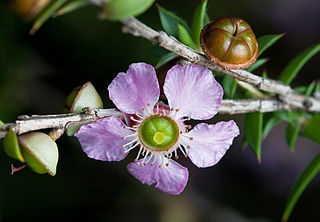
Leptospermum is a genus of shrubs and small trees in the myrtle family Myrtaceae commonly known as tea trees, although this name is sometimes also used for some species of Melaleuca. Most species are endemic to Australia, with the greatest diversity in the south of the continent, but some are native to other parts of the world, including New Zealand and Southeast Asia. Leptospermums all have five conspicuous petals and five groups of stamens which alternate with the petals. There is a single style in the centre of the flower and the fruit is a woody capsule.

Prostanthera, commonly known as mintbush or mint bush, is a genus of about 100 species of flowering plants in the mint family Lamiaceae, and all are endemic to Australia. Plants are usually shrubs, rarely trees with leaves in opposite pairs. The flowers are arranged in panicles in the leaf axils or on the ends of branchlets. The sepals are joined at the base with two lobes. The petals are usually blue to purple or white, joined in a tube with two "lips", the lower lip with three lobes and the upper lip with two lobes or notched.

Pimelea, commonly known as rice flowers, is a genus of plants belonging to the family Thymelaeaceae. There are about 150 species, including 110 in Australia and thirty six in New Zealand.

Persoonia, commonly known as geebungs or snottygobbles, is a genus of about one hundred species of flowering plants in the family Proteaceae. Plants in the genus Persoonia are shrubs or small trees usually with smooth bark, simple leaves and usually yellow flowers arranged along a raceme, each flower with a leaf or scale leaf at the base. The fruit is a drupe.
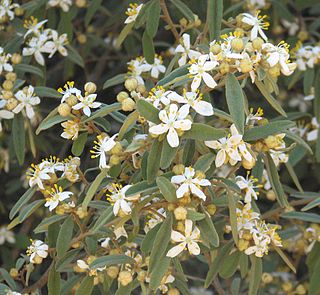
Asterolasia is a genus of seventeen species of erect or prostrate shrubs in the family Rutaceae, and is endemic to Australia. The leaves are simple and arranged alternately, the flowers arranged in umbel-like groups on the ends of branchlets or in leaf axils, usually with five sepals, five petals and ten to twenty-five stamens. There are seventeen species and they are found in all Australian mainland states but not in the Northern Territory.

Phebalium is a genus of thirty species of shrubs or small trees in the family Rutaceae and is endemic to Australia. The leaves are arranged alternately, simple and often warty, the flowers arranged singly or in umbels on the ends of branchlets or in leaf axils, usually with five sepals, five petals and ten stamens. There are about thirty species and they are found in all Australian states but not in the Northern Territory.
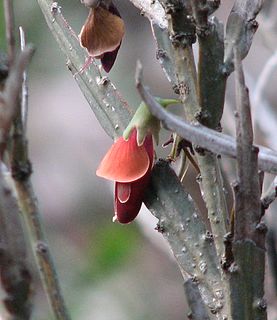
Bossiaea is a genus of about 78 species of flowering plants in the pea family Fabaceae and is endemic to Australia. Plants in this genus often have stems and branches modified as cladodes, simple, often much reduced leaves, flowers with the upper two sepal lobes larger than the lower three, usually orange to yellow petals with reddish markings, and the fruit a more or less flattened pod.

Philotheca myoporoides, commonly known as long-leaf wax flower, is a species of flowering plant in the family Rutaceae and is endemic to south-eastern Australia. It is a shrub with sessile, oblong to egg-shaped, glandular-warty leaves and white to pink flowers arranged singly in leaf axils. Prior to 1998 it was known as Eriostemon myoporoides.

Philotheca buxifolia is a species of flowering plant in the family Rutaceae and is endemic to New South Wales. It is a shrub with more or less oblong leaves and solitary white to pink flowers arranged singly on the ends of branchlets.
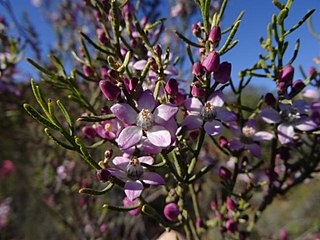
Philotheca brucei is a species of flowering plant in the family Rutaceae and is endemic to Western Australia. It is a shrub with cylindrical leaves grooved along the top and in spring, white to pink or mauve flowers with five egg-shaped petals.
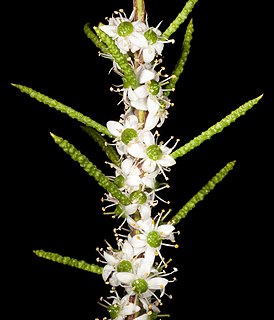
Philotheca deserti is a species of flowering plant in the family Rutaceae and is endemic to inland Western Australia. It is an erect shrub with narrow spindle-shaped, glandular-warty leaves and white flowers arranged singly in leaf axils.
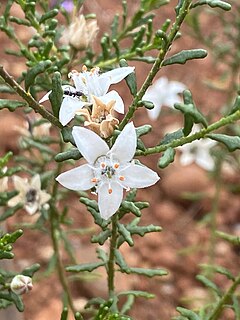
Philotheca difformis is a species of flowering plant in the family Rutaceae and is endemic to continental eastern Australia. It is a shrub with variably-shaped leaves depending on subspecies, and white flowers arranged singly or in groups of up to four on the ends of the branchlets. Subspecies difformis is commonly known as the small-leaf wax-flower.

Philotheca gardneri is a species of flowering plant in the family Rutaceae and is endemic to the south-west of Western Australia. It is a shrub with crowded, narrow club-shaped or more or less spherical leaves and white flowers with a prominent pink midrib, usually borne singly on the ends of branchlets.

Philotheca myoporoides subsp. acuta is a subspecies of flowering plant in the family Rutaceae and is endemic to New South Wales. It is a shrub with narrow oblong or narrow elliptic leaves and white flowers arranged singly or in groups of up to three in leaf axils.
Philotheca myoporoides subsp. euroensis is a subspecies of flowering plant in the family Rutaceae and is endemic to a small area in Victoria, Australia. It is a small shrub with curved, broadly elliptic leaves and white or pink flowers arranged singly or in groups of up to four in leaf axils.

Philotheca myoporoides subsp. myoporoides, commonly known as long-leaf wax flower, is a subspecies of flowering plant in the family Rutaceae and is endemic to south-eastern continental Australia. It is a shrub with oblong to elliptic or egg-shaped leaves and white or pink flowers arranged in groups of three to eight in leaf axils.

Philotheca scabra is a species of flowering plant in the family Rutaceae and is endemic to New South Wales. It is a small shrub with variably shaped leaves, depending on subspecies, and single white to pink flowers arranged on the ends of branchlets.





















